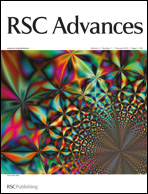X-Ray absorption fine structure spectroscopy studies of thermal effects on ion-exchange equilibria†
Abstract
The effect of temperature on the first-shell coordination structures for Rb+, Sr2+, Br−, and I− in aqueous solution and those for Rb+ and Sr2+ in a sulfonated styrene-divinylbenzene copolymer cation-exchange resin have been evaluated by X-ray absorption fine structure (XAFS) spectroscopy in order to elucidate the origin of the effect of temperature on ion-exchange equilibria. XAFS measurements on aqueous solutions containing the inorganic ions in the temperature range from ambient temperature to 175 °C at 3 MPa indicate that the number of coordinated first shell water molecules decreases with an increase in temperature, while the first shell ion–oxygen (water) bond length remains almost unchanged (Sr2+ and I−) or slightly decreases (Rb+ and Br−). The spectral changes observed for Rb+ and Sr2+ in the hydrated cation-exchange resin were nearly the same as those for the ions in aqueous solution, though there is an indication for the contact ion pairs with the fixed sulfonate groups at high temperatures. These data represent the direct spectroscopic confirmation of structural change around inorganic ions in an ion-exchange resin as well as in aqueous solutions. The effect of temperature on separation selectivity in ion-exchange processes can be interpreted by the change in hydration of ions clarified in the present study.


 Please wait while we load your content...
Please wait while we load your content...